Electoral boundaries committee convened in first formal step towards next Singapore GE
Sign up now: Get ST's newsletters delivered to your inbox

Singapore's next general election must be held by April 2021.
PHOTO: ST FILE
Rachel Au-Yong
Follow topic:
SINGAPORE - The committee that reviews Singapore's electoral boundaries and divisions has been formed - the first step leading to the next general election.
The Elections Department said on Wednesday (Sept 4) that the Electoral Boundaries Review Committee (EBRC) was convened last month.
The next general election has to be held by April 2021.
Its statement said the committee has been directed to review the current electoral boundaries and recommend the number and boundaries of group representation constituencies and single-member constituencies, taking into account significant changes in the number of electors in current electoral divisions due to population shifts and housing development.
The committee is also tasked with further reducing the average size of GRCs, and creating more SMCs than the current 13.
The size of GRCs has been steadily reduced, on average, from 5.4, following complaints that large ones make it even harder for opposition parties to field the required candidates for a team.
The average GRC size has dipped from five in 2011 to 4.75 at the 2015 General Election.
The Elections Department said the committee is in the midst of deliberations, and will make its recommendations to Prime Minister Lee Hsien Loong when it has completed its review.
The committee is chaired by the secretary to the Prime Minister, Mr Tan Kee Yong, who is also Cabinet Secretary.
As recently as July, Workers' Party chief Pritam Singh had filed a parliamentary question asking if the panel had been formed. The answer given on July 8 was no.
In the previous three elections that PM Lee had helmed, the committee had taken between two and four months to do its work.

For those elections from 2006 to 2015, the time between the release of this report and Polling Day ranged from one month and 19 days to two months and 14 days.
Historically, the time between the release of this report and Polling Day has ranged from 17 days to six months.
Political parties typically wait for the report to be made public to firm up their slates.
After the committee's report is published, the next stage in the lead-up to the polls is for Parliament to be dissolved and the Writ of Election issued.
The next step is Nomination Day, which must take place no earlier than five days and no later than one month after the writ is issued.
Nomination Day is the start of the campaign period, which is required by law to be a minimum of nine days.
There is then a Cooling-Off Day, which falls on the eve of Polling Day when voters cast their ballots.
In past elections, the interval between the committee's formation and Polling Day ranged from two to seven months.
This is the first time the Elections Department has made a formal announcement about the committee's formation under PM Lee's watch.
For the 2006 and 2015 polls, ministers announced in Parliament that the ERBC had been formed, in response to questions filed.
In the lead-up to the 2011 election, PM Lee announced the formation of the committee in response to questions from reporters.

